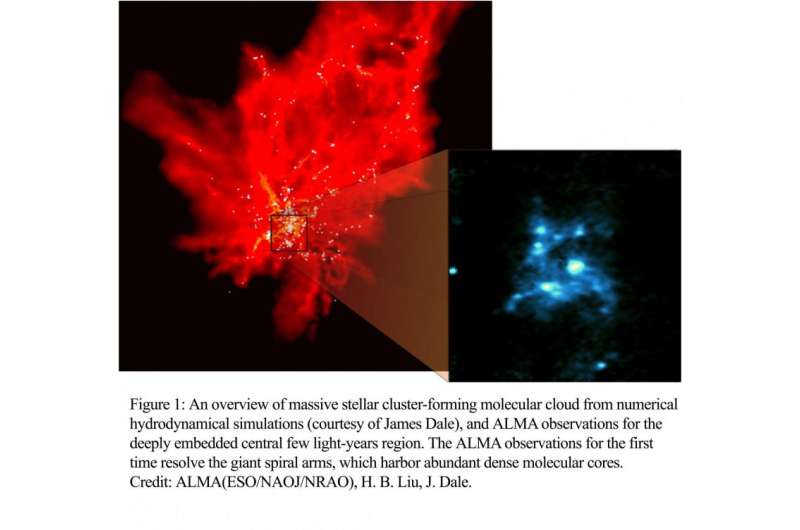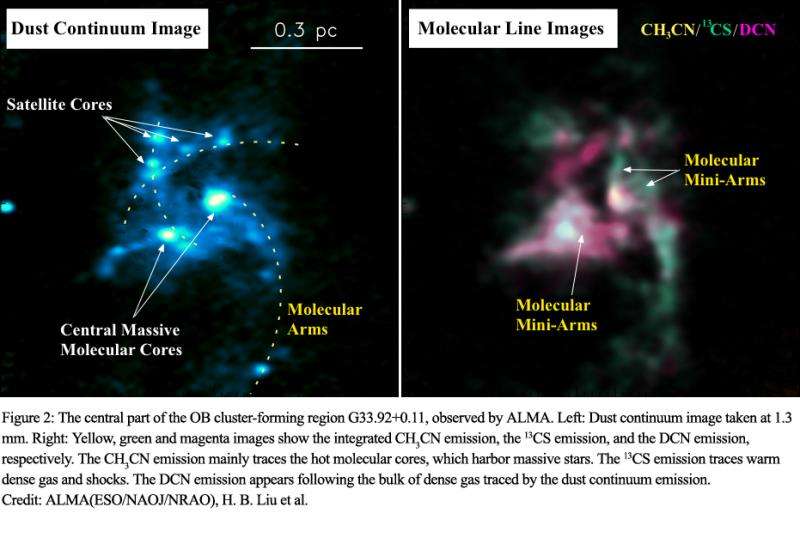Giant spiraling molecular gas arms as cradles of dense, massive molecular cores

A research team led by Hauyu Liu at the Institute of Astronomy and Astrophysics, Academia Sinica (ASIAA) observed the luminous OB cluster-forming massive molecular clump G33.92+0.11 with the Atacama Large Millimeter/submillimeter Array (ALMA), and unveiled the fine molecular gas structures deeply embedded at the center of the parent molecular cloud. This finding provides a greatly simplified picture of overall cloud geometry and kinematics, which represents a crucial step forward in the understanding of the upper end of the stellar and molecular core mass functions. The research was published in the April 28 issue of the Astrophysical Journal.
Via ALMA observations, this research for the first time resolved an embedded giant coherent dense gas structure on a several light-year scale. Surprisingly, this dense gas structure presents several spiral arms, which appear like a version of the previously observed spiral arms surrounding the low-mass protobinary, scaled-up by a factor of ~103. These giant spiral arms, and the massive molecular gas cores located at their convergence, are cradles to form the highest mass stars in this stellar cluster.
How the young massive stellar clusters (YMCs) and globular clusters (GCs) come into existence, remains a fundamental question in astrophysics. To form such complex systems, it is necessary for massive amounts of gas to be converted into stars with little loss before they start to disperse the gas by the action of their winds—so-called stellar feedback—and such a process is far from trivial. The formation of these systems likely requires a special geometry and dynamical evolution of the natal molecular cloud.
ALMA observations found that this massive cluster-forming molecular cloud is undergoing a rapid global gravitational collapse. The residual specific angular momentum leads to the formation of a ~3 light year scale, flattened, dense rotating gas structure. The highest mass stars form in the central dense molecular gas cores at the center of this flattened rotating structure. In addition, several giant spiral arms form in this flattened rotating structure due to gravitational instability. These spiral arms further fragment to form satellite dense molecular gas cores. Star formations in the central and satellite dense molecular cores are self-shielded from the radiative and mechanical feedback of ambient (proto)stars, which is the key to permit a high star-forming efficiency.
"The long term development of our institute in this field based on the Submillimeter Array, has made our research into high-mass star-formation competitive in the international arena, which has also paved the way for addressing the most important questions in the follow-up ALMA observations" said the lead author Liu.

More information: ALMA Resolves the Spiraling Accretion Flow in the Luminous OB Cluster-forming Region G33.92+0.11 ApJ 804 37, DOI: 10.1088/0004-637X/804/1/37
Journal information: Astrophysical Journal
Provided by Academia Sinica





















